Page 655 of 700
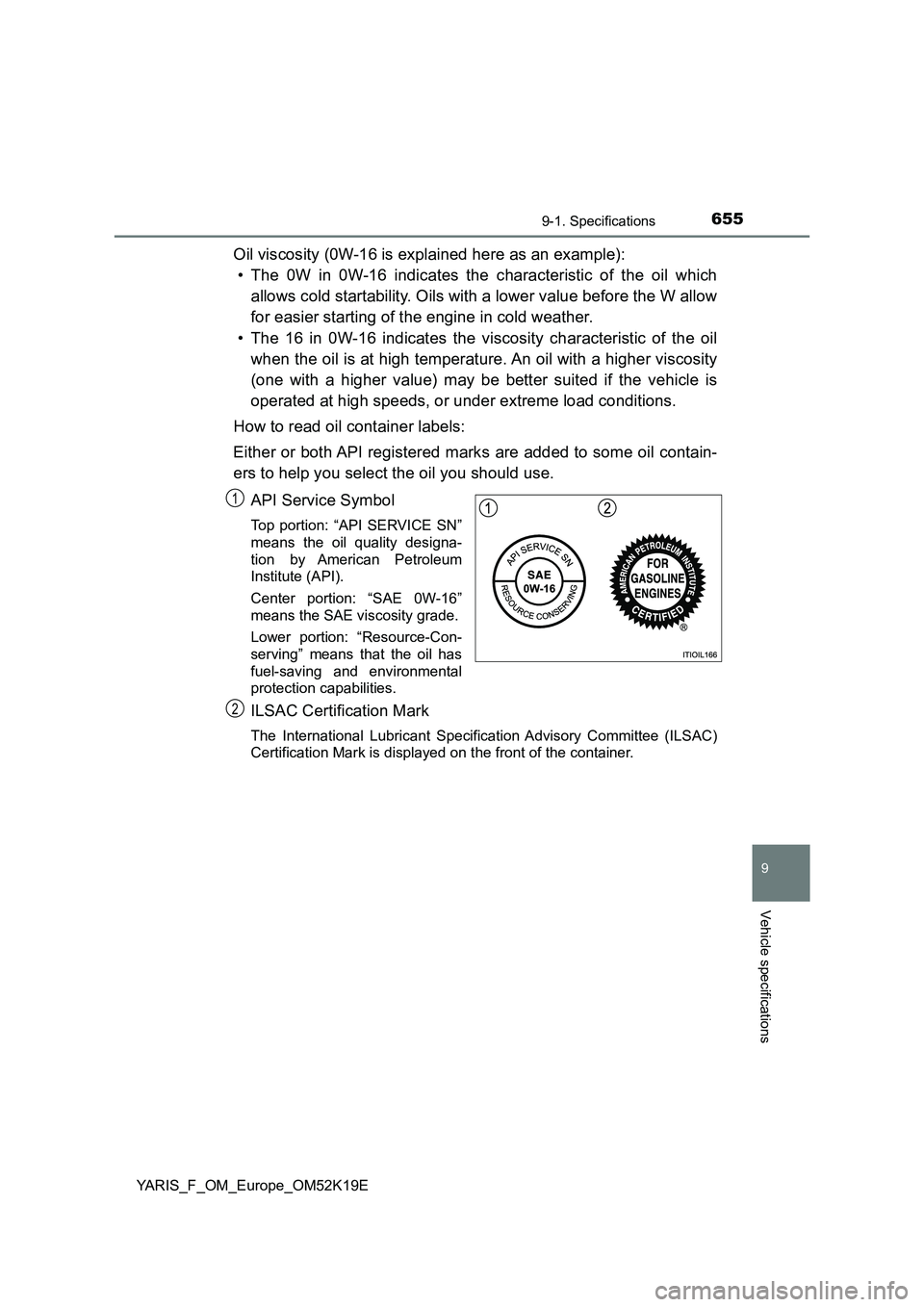
6559-1. Specifications
9
Vehicle specifications
YARIS_F_OM_Europe_OM52K19E
Oil viscosity (0W-16 is explained here as an example):
• The 0W in 0W-16 indicates the characteristic of the oil which
allows cold startability. Oils with a lower value before the W allow
for easier starting of the engine in cold weather.
• The 16 in 0W-16 indicates the viscosity characteristic of the oil
when the oil is at high temperature. An oil with a higher viscosity
(one with a higher value) may be better suited if the vehicle is
operated at high speeds, or under extreme load conditions.
How to read oil container labels:
Either or both API registered marks are added to some oil contain-
ers to help you select the oil you should use.
API Service Symbol
Top portion: “API SERVICE SN”
means the oil quality designa-
tion by American Petroleum
Institute (API).
Center portion: “SAE 0W-16”
means the SAE viscosity grade.
Lower portion: “Resource-Con-
serving” means that the oil has
fuel-saving and environmental
protection capabilities.
ILSAC Certification Mark
The International Lubricant Specification Advisory Committee (ILSAC)
Certification Mark is displayed on the front of the container.
1
2
Page 656 of 700
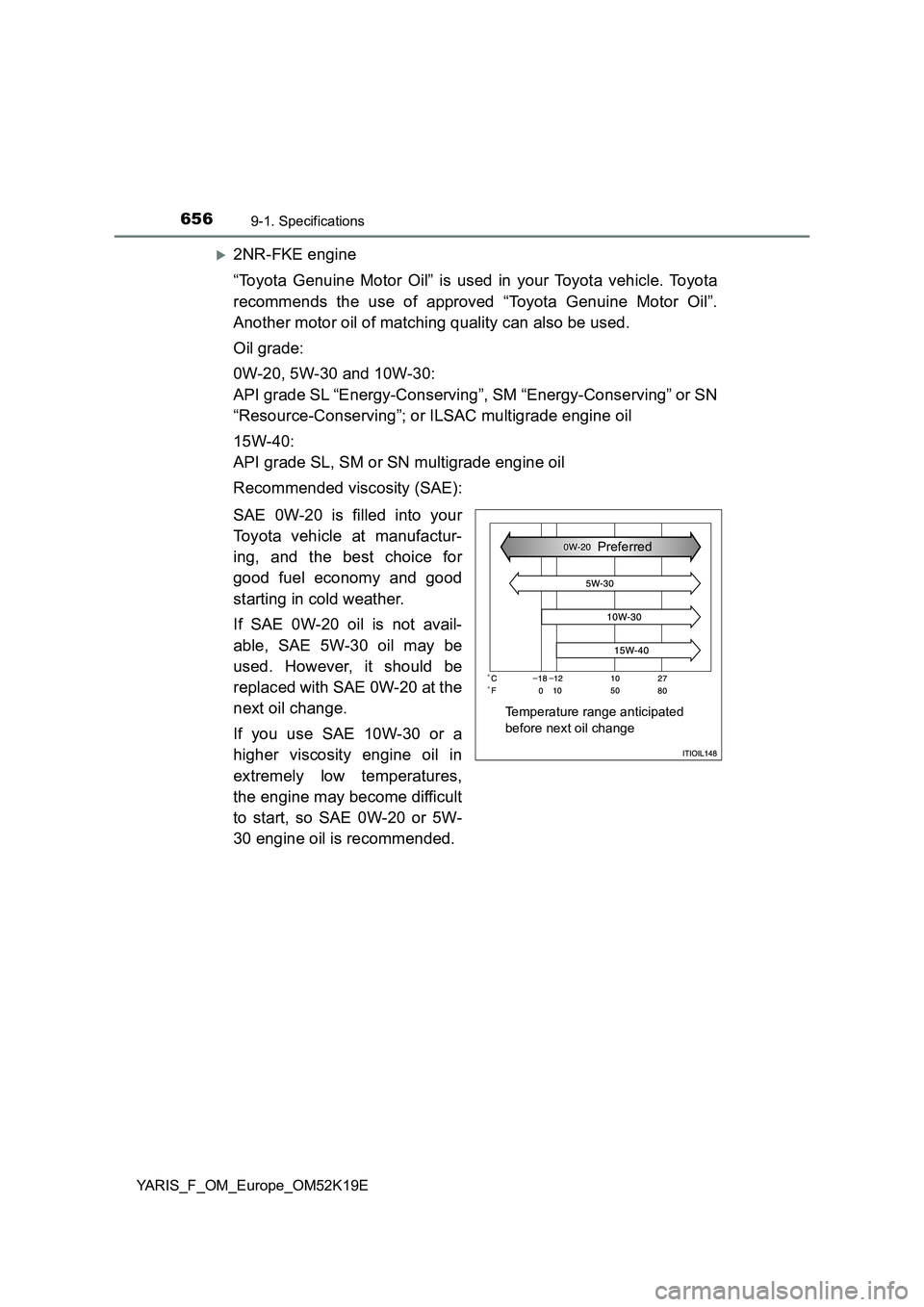
6569-1. Specifications
YARIS_F_OM_Europe_OM52K19E
2NR-FKE engine
“Toyota Genuine Motor Oil” is used in your Toyota vehicle. Toyota
recommends the use of approved “Toyota Genuine Motor Oil”.
Another motor oil of matching quality can also be used.
Oil grade:
0W-20, 5W-30 and 10W-30:
API grade SL “Energy-Conserving”, SM “Energy-Conserving” or SN
“Resource-Conserving”; or ILSAC multigrade engine oil
15W-40:
API grade SL, SM or SN multigrade engine oil
Recommended viscosity (SAE):
SAE 0W-20 is filled into your
Toyota vehicle at manufactur-
ing, and the best choice for
good fuel economy and good
starting in cold weather.
If SAE 0W-20 oil is not avail-
able, SAE 5W-30 oil may be
used. However, it should be
replaced with SAE 0W-20 at the
next oil change.
If you use SAE 10W-30 or a
higher viscosity engine oil in
extremely low temperatures,
the engine may become difficult
to start, so SAE 0W-20 or 5W-
30 engine oil is recommended.
Temperature range anticipated
before next oil change
Preferred
Page 657 of 700
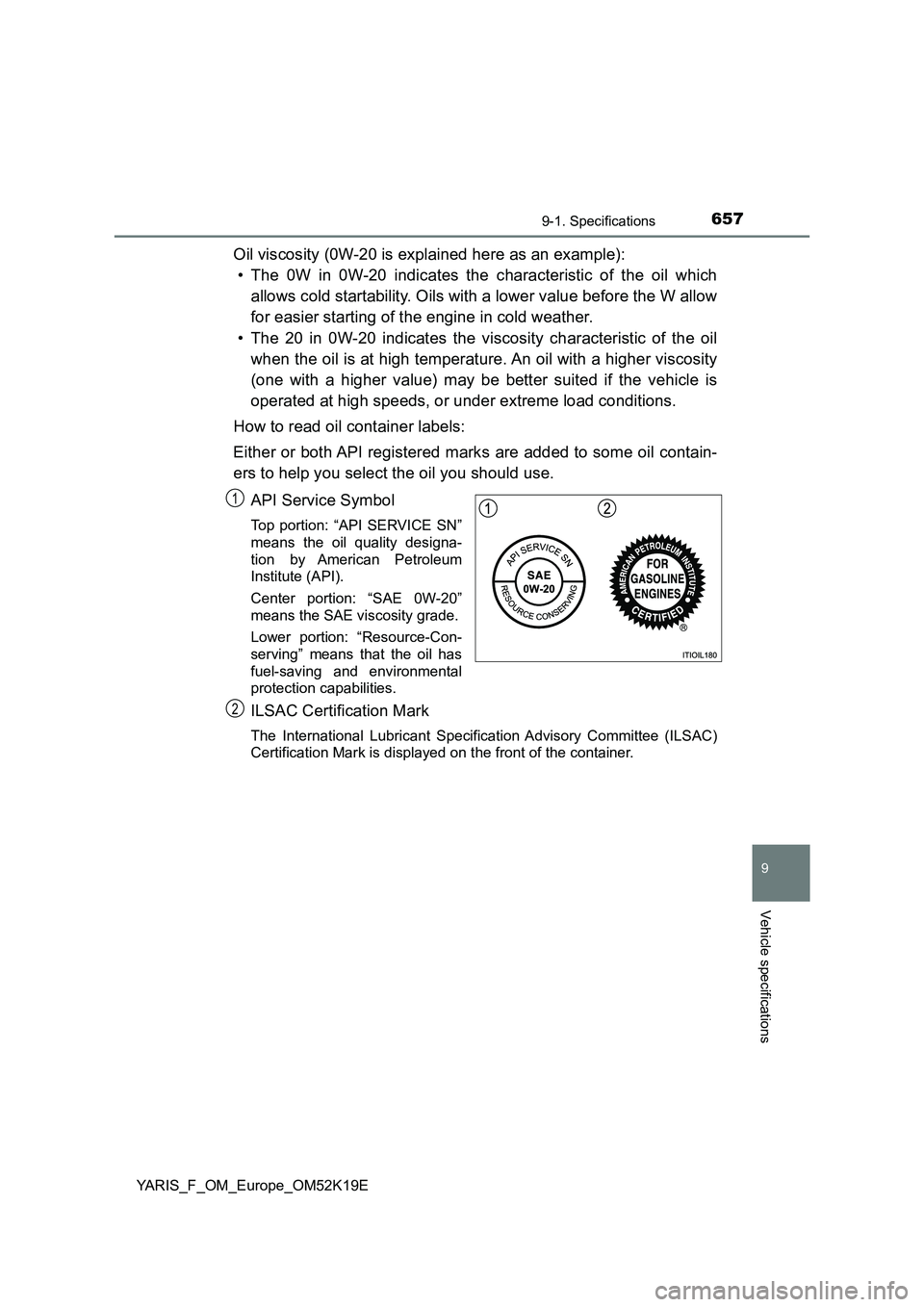
6579-1. Specifications
9
Vehicle specifications
YARIS_F_OM_Europe_OM52K19E
Oil viscosity (0W-20 is explained here as an example):
• The 0W in 0W-20 indicates the characteristic of the oil which
allows cold startability. Oils with a lower value before the W allow
for easier starting of the engine in cold weather.
• The 20 in 0W-20 indicates the viscosity characteristic of the oil
when the oil is at high temperature. An oil with a higher viscosity
(one with a higher value) may be better suited if the vehicle is
operated at high speeds, or under extreme load conditions.
How to read oil container labels:
Either or both API registered marks are added to some oil contain-
ers to help you select the oil you should use.
API Service Symbol
Top portion: “API SERVICE SN”
means the oil quality designa-
tion by American Petroleum
Institute (API).
Center portion: “SAE 0W-20”
means the SAE viscosity grade.
Lower portion: “Resource-Con-
serving” means that the oil has
fuel-saving and environmental
protection capabilities.
ILSAC Certification Mark
The International Lubricant Specification Advisory Committee (ILSAC)
Certification Mark is displayed on the front of the container.
1
2
Page 658 of 700
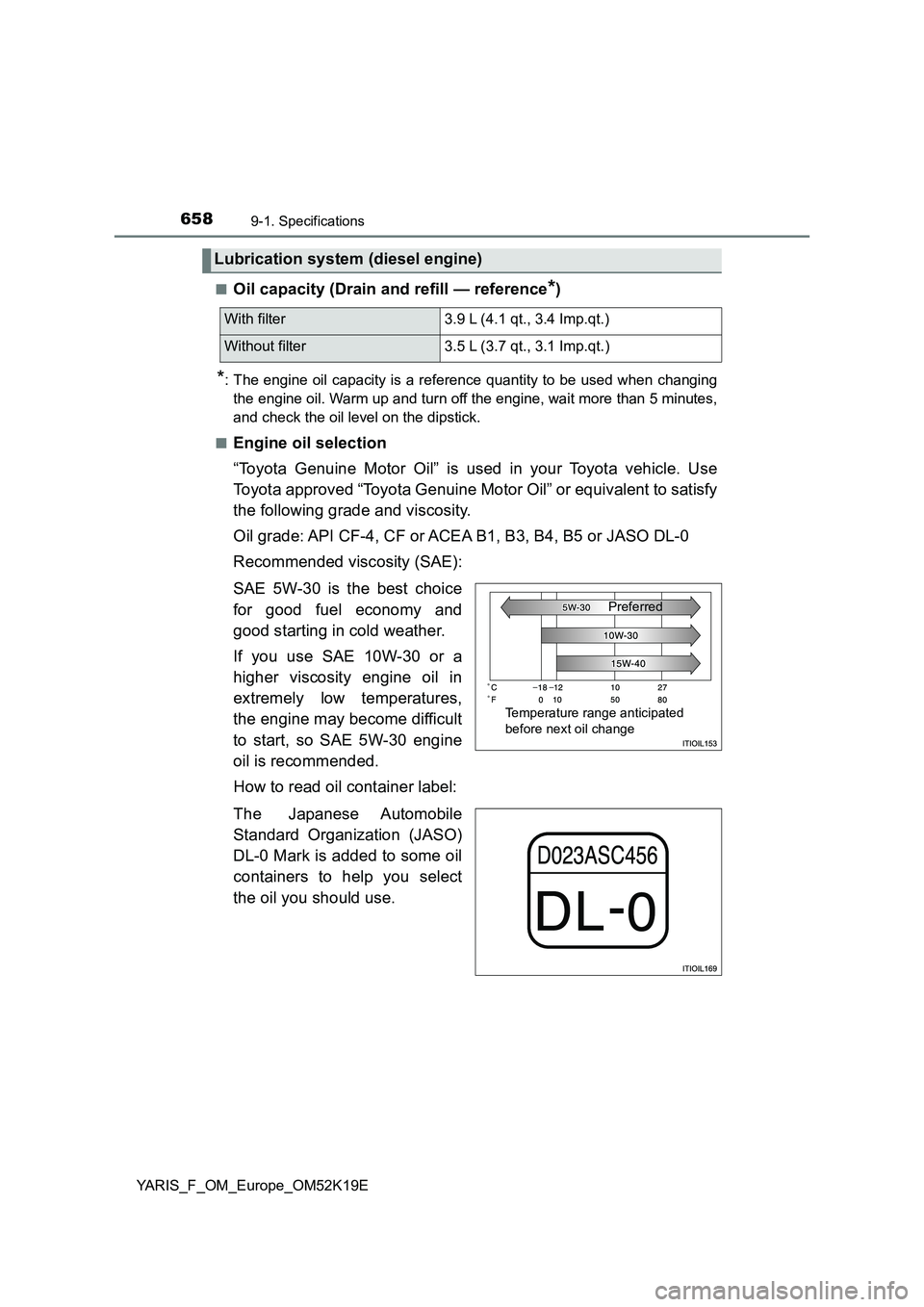
6589-1. Specifications
YARIS_F_OM_Europe_OM52K19E
■Oil capacity (Drain and refill — reference*)
*: The engine oil capacity is a reference quantity to be used when changing
the engine oil. Warm up and turn off the engine, wait more than 5 minutes,
and check the oil level on the dipstick.
■Engine oil selection
“Toyota Genuine Motor Oil” is used in your Toyota vehicle. Use
Toyota approved “Toyota Genuine Motor Oil” or equivalent to satisfy
the following grade and viscosity.
Oil grade: API CF-4, CF or ACEA B1, B3, B4, B5 or JASO DL-0
Recommended viscosity (SAE):
SAE 5W-30 is the best choice
for good fuel economy and
good starting in cold weather.
If you use SAE 10W-30 or a
higher viscosity engine oil in
extremely low temperatures,
the engine may become difficult
to start, so SAE 5W-30 engine
oil is recommended.
How to read oil container label:
The Japanese Automobile
Standard Organization (JASO)
DL-0 Mark is added to some oil
containers to help you select
the oil you should use.
Lubrication system (diesel engine)
With filter 3.9 L (4.1 qt., 3.4 Imp.qt.)
Without filter 3.5 L (3.7 qt., 3.1 Imp.qt.)
Temperature range anticipated
before next oil change
Preferred
Page 661 of 700
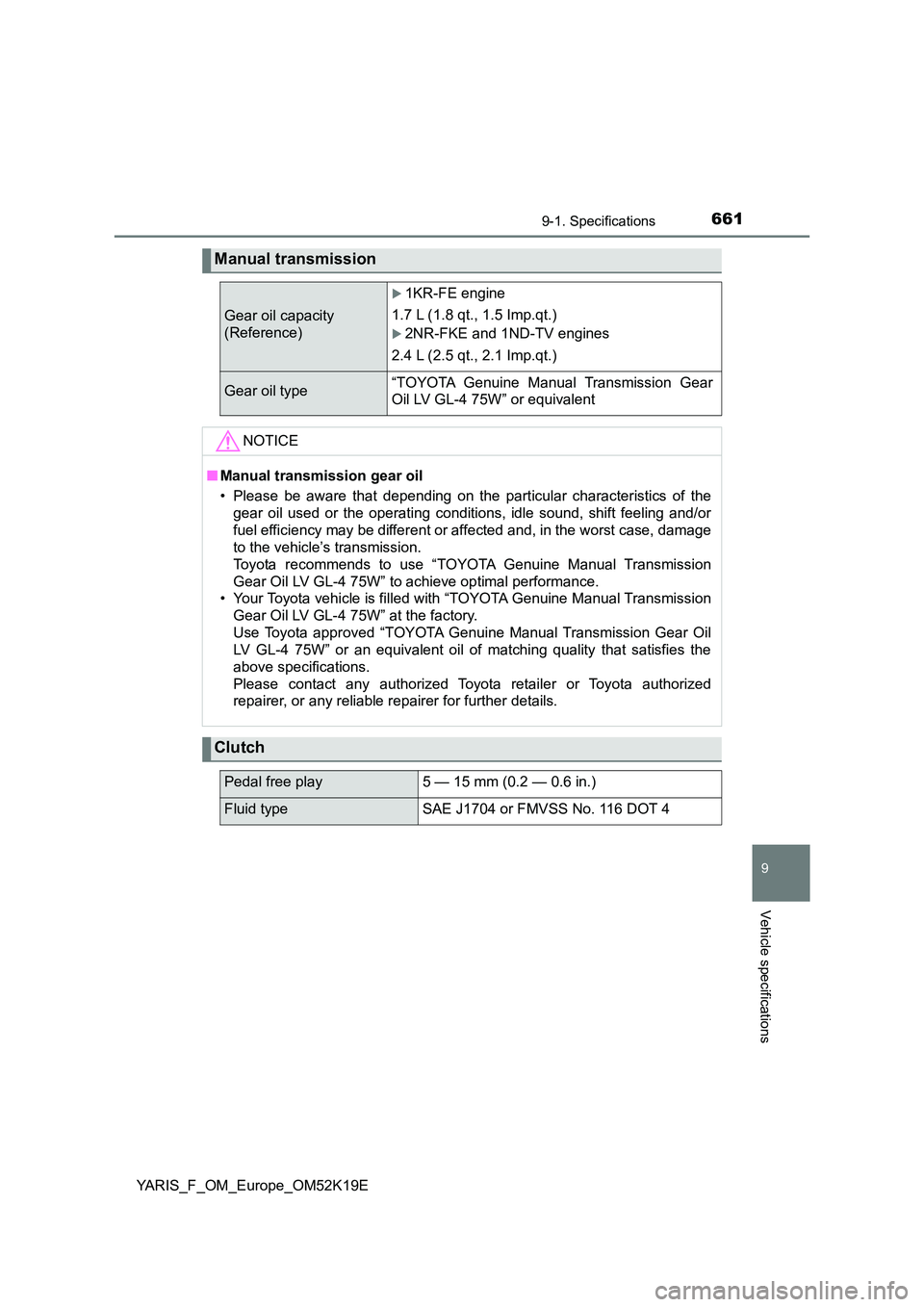
6619-1. Specifications
9
Vehicle specifications
YARIS_F_OM_Europe_OM52K19E
Manual transmission
Gear oil capacity
(Reference)
1KR-FE engine
1.7 L (1.8 qt., 1.5 Imp.qt.)
2NR-FKE and 1ND-TV engines
2.4 L (2.5 qt., 2.1 Imp.qt.)
Gear oil type“TOYOTA Genuine Manual Transmission Gear
Oil LV GL-4 75W” or equivalent
NOTICE
■ Manual transmission gear oil
• Please be aware that depending on the particular characteristics of the
gear oil used or the operating conditions, idle sound, shift feeling and/or
fuel efficiency may be different or affected and, in the worst case, damage
to the vehicle’s transmission.
Toyota recommends to use “TOYOTA Genuine Manual Transmission
Gear Oil LV GL-4 75W” to achieve optimal performance.
• Your Toyota vehicle is filled with “TOYOTA Genuine Manual Transmission
Gear Oil LV GL-4 75W” at the factory.
Use Toyota approved “TOYOTA Genuine Manual Transmission Gear Oil
LV GL-4 75W” or an equivalent oil of matching quality that satisfies the
above specifications.
Please contact any authorized Toyota retailer or Toyota authorized
repairer, or any reliable repairer for further details.
Clutch
Pedal free play5 — 15 mm (0.2 — 0.6 in.)
Fluid typeSAE J1704 or FMVSS No. 116 DOT 4
Page 664 of 700

6649-1. Specifications
YARIS_F_OM_Europe_OM52K19E
15-inch tires (Type A)
*: For some models, ECO tire pressure is shown on the tire pressure label.
( P. 600)
“For optimizing fuel economy, ECO tire pressure is recommended.
Tire pressure affects traveling comfort, road noise and steering character-
istics.”
15-inch tires (Type B: vehicles with rough road package)
Tire size175/65R15 84H
Tire inflation pressure
(Recommended cold
tire inflation pressure)
Front wheel
kPa (kgf/cm2 or bar, psi)
Rear wheel
kPa (kgf/cm2 or bar, psi)
Standard tire pressure:
230 (2.3, 33)
ECO tire pressure*:
250 (2.5, 36)
Standard tire pressure:
220 (2.2, 32)
ECO tire pressure*:
240 (2.4, 35)
Wheel size15 5J, 15 5 1/2J
Wheel nut torque103 N·m (10.5 kgf·m, 76 ft·lbf)
Tire size185/60R15 84H
Tire inflation pressure
(Recommended cold
tire inflation pressure)
Vehicle speed
Front wheel
kPa (kgf/cm2
or bar, psi)
Rear wheel
kPa (kgf/cm2 or
bar, psi)
160 km/h
(99 mph) or
less
220 (2.2, 32)220 (2.2, 32)
More than
160 km/h
(99 mph)
240 (2.4, 35)220 (2.2, 32)
Wheel size15 5 1/2J
Wheel nut torque103 N·m (10.5 kgf·m, 76 ft·lbf)
Page 665 of 700

6659-1. Specifications
9
Vehicle specifications
YARIS_F_OM_Europe_OM52K19E
15-inch tires (Type C: vehicles without rough road package)
*: For some models, ECO tire pressure is shown on the tire pressure label.
( P. 600)
“For optimizing fuel economy, ECO tire pressure is recommended.
Tire pressure affects traveling comfort, road noise and steering character-
istics.”
16-inch tires
Tire size185/60R15 84H
Tire inflation pressure
(Recommended cold
tire inflation pressure)
Front wheel
kPa (kgf/cm2 or bar, psi)
Rear wheel
kPa (kgf/cm2 or bar, psi)
Standard tire pressure:
230 (2.3, 33)
ECO tire pressure*:
250 (2.5, 36)
Standard tire pressure:
220 (2.2, 32)
ECO tire pressure*:
240 (2.4, 35)
Wheel size15 5 1/2J
Wheel nut torque103 N·m (10.5 kgf·m, 76 ft·lbf)
Tire size195/50R16 84V
Tire inflation pressure
(Recommended cold
tire inflation pressure)
Vehicle speed
Front wheel
kPa (kgf/cm2
or bar, psi)
Rear wheel
kPa (kgf/cm2 or
bar, psi)
160 km/h
(99 mph) or
less
220 (2.2, 32)200 (2.0, 29)
More than
160 km/h
(99 mph)
240 (2.4, 35)210 (2.1, 30)
Wheel size16 6J
Wheel nut torque103 N·m (10.5 kgf·m, 76 ft·lbf)
Page 668 of 700
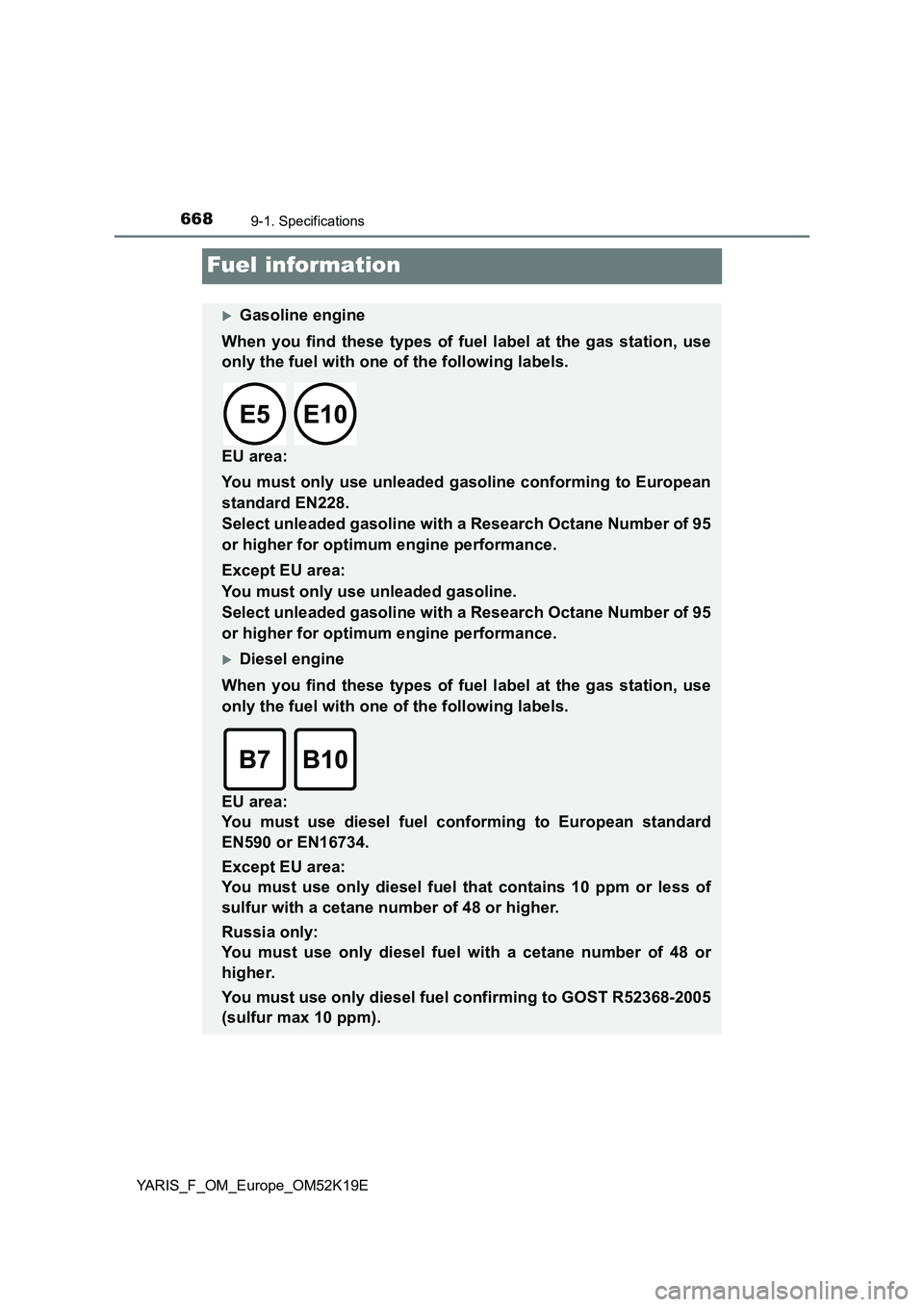
6689-1. Specifications
YARIS_F_OM_Europe_OM52K19E
Fuel information
Gasoline engine
When you find these types of fuel label at the gas station, use
only the fuel with one of the following labels.
EU area:
You must only use unleaded gasoline conforming to European
standard EN228.
Select unleaded gasoline with a Research Octane Number of 95
or higher for optimum engine performance.
Except EU area:
You must only use unleaded gasoline.
Select unleaded gasoline with a Research Octane Number of 95
or higher for optimum engine performance.
Diesel engine
When you find these types of fuel label at the gas station, use
only the fuel with one of the following labels.
EU area:
You must use diesel fuel conforming to European standard
EN590 or EN16734.
Except EU area:
You must use only diesel fuel that contains 10 ppm or less of
sulfur with a cetane number of 48 or higher.
Russia only:
You must use only diesel fuel with a cetane number of 48 or
higher.
You must use only diesel fuel confirming to GOST R52368-2005
(sulfur max 10 ppm).